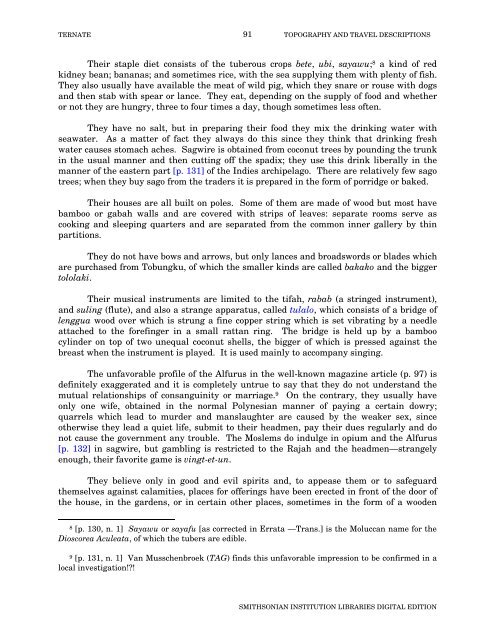Ternate - Smithsonian Institution Libraries
Ternate - Smithsonian Institution Libraries
Ternate - Smithsonian Institution Libraries
Create successful ePaper yourself
Turn your PDF publications into a flip-book with our unique Google optimized e-Paper software.
TERNATE 91 TOPOGRAPHY AND TRAVEL DESCRIPTIONS<br />
Their staple diet consists of the tuberous crops bete, ubi, sayawu; 8 a kind of red<br />
kidney bean; bananas; and sometimes rice, with the sea supplying them with plenty of fish.<br />
They also usually have available the meat of wild pig, which they snare or rouse with dogs<br />
and then stab with spear or lance. They eat, depending on the supply of food and whether<br />
or not they are hungry, three to four times a day, though sometimes less often.<br />
They have no salt, but in preparing their food they mix the drinking water with<br />
seawater. As a matter of fact they always do this since they think that drinking fresh<br />
water causes stomach aches. Sagwire is obtained from coconut trees by pounding the trunk<br />
in the usual manner and then cutting off the spadix; they use this drink liberally in the<br />
manner of the eastern part [p. 131] of the Indies archipelago. There are relatively few sago<br />
trees; when they buy sago from the traders it is prepared in the form of porridge or baked.<br />
Their houses are all built on poles. Some of them are made of wood but most have<br />
bamboo or gabah walls and are covered with strips of leaves: separate rooms serve as<br />
cooking and sleeping quarters and are separated from the common inner gallery by thin<br />
partitions.<br />
They do not have bows and arrows, but only lances and broadswords or blades which<br />
are purchased from Tobungku, of which the smaller kinds are called bakako and the bigger<br />
tololaki.<br />
Their musical instruments are limited to the tifah, rabab (a stringed instrument),<br />
and suling (flute), and also a strange apparatus, called tulalo, which consists of a bridge of<br />
lenggua wood over which is strung a fine copper string which is set vibrating by a needle<br />
attached to the forefinger in a small rattan ring. The bridge is held up by a bamboo<br />
cylinder on top of two unequal coconut shells, the bigger of which is pressed against the<br />
breast when the instrument is played. It is used mainly to accompany singing.<br />
The unfavorable profile of the Alfurus in the well-known magazine article (p. 97) is<br />
definitely exaggerated and it is completely untrue to say that they do not understand the<br />
mutual relationships of consanguinity or marriage. 9 On the contrary, they usually have<br />
only one wife, obtained in the normal Polynesian manner of paying a certain dowry;<br />
quarrels which lead to murder and manslaughter are caused by the weaker sex, since<br />
otherwise they lead a quiet life, submit to their headmen, pay their dues regularly and do<br />
not cause the government any trouble. The Moslems do indulge in opium and the Alfurus<br />
[p. 132] in sagwire, but gambling is restricted to the Rajah and the headmen—strangely<br />
enough, their favorite game is vingt-et-un.<br />
They believe only in good and evil spirits and, to appease them or to safeguard<br />
themselves against calamities, places for offerings have been erected in front of the door of<br />
the house, in the gardens, or in certain other places, sometimes in the form of a wooden<br />
8 [p. 130, n. 1] Sayawu or sayafu [as corrected in Errata —Trans.] is the Moluccan name for the<br />
Dioscorea Aculeata, of which the tubers are edible.<br />
9 [p. 131, n. 1] Van Musschenbroek (TAG) finds this unfavorable impression to be confirmed in a<br />
local investigation!?!<br />
SMITHSONIAN INSTITUTION LIBRARIES DIGITAL EDITION

















